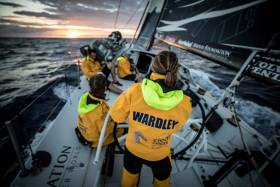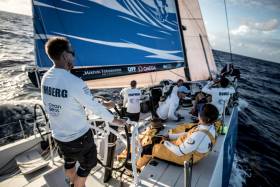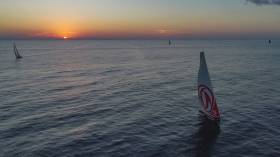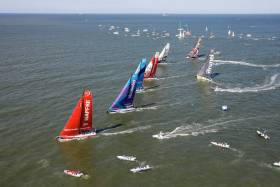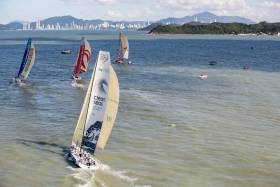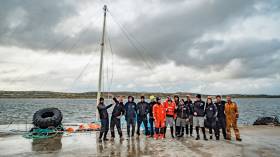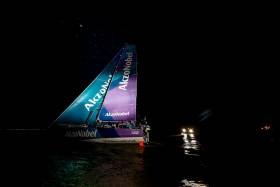Displaying items by tag: VOR
Volvo Ocean Race Up For Sale?
#VOR - Is the Volvo Ocean Race up for sale? Yachting World reports that sources close to the event say a potential bid from at least two prospective buyers is apparently in the offing.
The speculation comes as the race comes close to adopting the IMOCA 60 as its new design standard for future events, a move that would significantly lower the cost and barriers of entry for teams.
“Loads of teams in IMOCA would have an ambition to do the VOR,” says Alex Thomson, the offshore sailing veteran who also sits on the IMOCA class board.
As for the current Volvo Ocean Race competitors, Turn the Tide on Plastic and Vestas 11th Hour Racing blitzed to the head of the fleet on Wednesday as the battle for Leg 8 glory continued due east of Rio de Janeiro on Wednesday (25 April).
The leading pair were the most easterly boats as the seven-strong fleet approached an oil field exclusion zone 100 miles off Rio’s coast, enabling them to continue make headway north for longer while their rivals were forced to tack.
At 0330 UTC, as the westerly boats tacked, the teams were practically neck and neck split west to east by around 12 miles. By 1300 UTC, all seven boats were back on starboard tack heading north north-east once more.
But Turn the Tide on Plastic’s lead had grown to 16 miles, with Vestas 11th Hour Racing less than a mile off their tail.
“We have sailed within sight of Vestas for the last 24 hours having lost sight of the others as we all tacked on the shifts around a huge cloud yesterday afternoon,” Turn the Tide skipper Dee Caffari said.
“There was lots of rain, so much we were either going to grow from being watered so much or shrink from excessive water.
“We are currently sailing along the outside of an exclusion area, another oil field. The winds are light and the sea state flat. We are still with Vestas and the others it seems are behind us. Gotta be happy with that!”
Caffari reported a jubilant mood from her crew this morning – all apart from young Brit Henry Bomby, who discovered that he left his toothbrush in Itajaí.
“Liz [Wardley, TTOP boat captain] has offered me the one from the tool kit/winch parts,” he wrote. “Not that desperate, yet…”
A 17-mile lead might seem insignificant in a leg of 5,600 miles but it will give Turn the Tide and Vestas 11th Hour Racing a chance to expand the advantage once they hit the south-easterly trade winds in the next couple of days.
It is often the case that, in the trades, the rich get richer as they capitalise on better, more stable breeze. The five chasing teams must choose wisely if they are to hold on to the leading pair.
“It’s pretty important to get good position over the next 24 hours before we get into the trade winds because from that point onwards it will be a bit of a procession,” said Kyle Langford, crew on seventh-placed Team Brunel. “The next 24 hours are critical – it will set up how we sit for the next week or so.”
Prior to tacking back on to starboard, Sun Hung Kai/Scallywag were trailing the fleet in the official standings, chasing down Team Akzonobel.
At 1300 UTC, Dave Witt’s crew were up to fourth having overhauled Akzonbel, MAPFRE and Brunel, and pulled back almost two miles on Turn the Tide on Plastic.
“In the grand scheme of things we’ve still got 4,500 miles still to go so this gap is nothing,” Scallywag’s Trystan Seal said. “We’ve just got to keep in touch and find our time to pounce.”
Leg 8 Position Report, Wednesday 25 April (Day 4) at 2pm Irish time/1pm UTC:
- Turn The Tide on Plastic - DTF 4,526.81 nautical miles
- Vestas 11th Hour Racing +0.57 nautical miles
- Dongfeng Race Team +15.99
- Sun Hung Kai/Scallywag +17.40
- MAPFRE +17.98
- Team AkzoNobel +19.48
- Team Brunel +20.21
#VOR - Dongfeng Race Team snuck into the lead on Tuesday (24 April) as the Volvo Ocean Race fleet continued to skirt Leg 8’s first major obstacle – the St Helena High.
The famed anticyclone is renowned for dominating the South Atlantic and making tricky sailing for Volvo Ocean Race teams heading north or south.
Constantly expanding and contracting, the St Helena High – also known as the South Atlantic High Pressure Cell – is currently centred around 1,300 miles east of the Leg 8 start city Itajaí.
However, its influence stretches 1,000 miles in every direction, causing a major navigational problem for the seven Volvo Ocean Race teams.
Charles Caudrelier’s Dongfeng had the upper hand – albeit a very small one – as the 1300 UTC position report was released showing the Franco-Chinese outfit with a two-mile jump on second-placed MAPFRE.
Around 16 miles separated Dongfeng in the east from Sun Hung Kai/Scallywag, the most westerly boat, while Team Brunel were the most southerly boat some five miles below the leaders before zig-zagging north with MAPFRE.
“It’s the classic upwind slog – and we’ve probably got this for six days,” said Dongfeng’s Daryl Wislang.
“We’ve done a pretty good job at the moment actually, everyone else is behind us. I don’t mind it being upwind so long as everyone else is behind us. It’s a pleasant change – it reminds us that what we’ve just endured [in the Southern Ocean] is pretty special.”
The long-term strategy remains to get east as fast as possible, in search of stronger, more favourable breeze and less current deeper in the South Atlantic.
In order to do that, the teams have had plenty of tacks and sail changes with more in store as they zigzag their way around the St Helena High’s north-western edge.
It’s made for a testing first two days to Leg 8, which will see them race 5,700 miles north to the American yachting mecca of Newport, Rhode Island.
“We’ve had quite a lot of cloud activity,” explained Scallywag crewman Pete Cumming, a new addition to the team for Leg 8. “They’re sucking and blowing, and when you’re on the edge of the clouds the wind does very different things.
“It’s really up and down, and swinging all over the place. You have to just position yourself how you think you’ll get the best out of them.”
Onboard Team AkzoNobel, the ever-changing wind speed and direction has been causing havoc with their sail selection.
“The difficulty is we’re right on the crossover of our sails between the masthead code zero and the J1 jib,” AkzoNobel’s Luke Molloy said.
“We were sailing in and out of the crossover all yesterday afternoon and into the evening. The problem is that if you take the time to do the sail change you need to then consider how much distance you lose versus how much you gain with the new sail.”
With less than 500 miles sailed, the race to Newport is only just warming up.
The race tracker will remain live till 8pm IST/7pm UTC when it will revert to regular race-time position updates.
Leg 8 Position Report, Tuesday 24 April (Day 3) at 7.14pm Irish time/6.14pm UTC:
- Dongfeng Race Team - DTF 4,652.6 nautical miles
- Team Brunel +2.0 nautical miles
- MAPFRE +2.6
- Team AkzoNobel +4.9
- Sun Hung Kai/Scallywag +8.4
- Vestas 11th Hour Racing +12.3
- Turn The Tide on Plastic +12.9
Volvo Ocean Race Fleet Switches Back To Race Mode
#VOR - Following a big send-off from Itajai yesterday (Sunday 22 April), the seven-strong Volvo Ocean Race fleet – back up to full complement with the welcome return of Vestas 11th Hour Racing and Sun Hung Kai/Scallywag – faced a tricky opening night of unpredictable weather.
There was little chance for the sailors to acclimatise slowly as constant variations in wind direction and strength meant numerous sail changes.
“It’s very unstable – the wind’s up and down by ten knots, and 30 degrees left to right,” said Team AkzoNobel skipper Simeon Tienpont. “We’ve got plenty going on on deck, that’s for sure.”
Onboard Turn the Tide on Plastic, skipper Dee Caffari welcomed the slightly more stable conditions that greeted the teams with sunrise.
“The first night at sea is always interesting,” she said. “It takes a little while to get back into the routine and with all the boats so close together it can change the way you sail.
“Even now at first light we can all see everyone clearly and we are all on the same sail combination doing the same thing. We had a few clouds in the early hours resulting in some wind shifts, some changes in pressure and some rain, but now the skies all seem a bit more consistent.”
MAPFRE were the early leaders in the opening hours but Xabi Fernandez’s crew were reeled in after they got caught out by a cloud.
“We’re all good here after a tricky start,” Fernandez said. “Over the night we’ve had a little bit of action and we lost our position a little bit.”
At 1300 UTC (1400 IST), and with just over 200 miles of the 5,700-mile leg ticked off, it was Turn the Tide on Plastic that topped the table, with Brunel in second and Scallywag, the most northerly boat, in third.
The more southerly-positioned Dongfeng Race Team, Vestas 11th Hour Racing, MAPFRE and AkzoNobel were in fourth to seventh respectively.
However, the ranking is calculated to a series of waypoints without taking into account routing due to weather, and in reality less than five miles separate first to last place at this early stage.
While the Leg 8 finish line in Newport, Rhode Island lies some 4,000 miles north, the teams are battling to get east as quickly as possible so they can hook into stronger breeze that will fire them around Brazil’s most easterly point.
Over the course of the day, the breeze is forecast to weaken and shift to the right, forcing the teams into a tactical tacking battle as the sun sets.
Fans of the race can follow the action in real time, as the tracker will remain live for the first 48 hours of the leg.
Leg 8 Position Report, Monday 23 April (Day 2) at 3.45pm Irish time/2.45pm UTC:
- Sun Hung Kai/Scallywag - DTF 4.879.2 nautical miles
- Turn The Tide on Plastic +1 nautical miles
- Team Brunel +1.1
- Dongfeng Race Team +1.6
- MAPFRE +1.9
- Vestas 11th Hour Racing +2.2
- Team AkzoNobel +2.9
MAPFRE Leads Full Volvo Ocean Race Fleet From Itajaí To Newport
#VOR - It was a familiar sight on Sunday afternoon (22 April) in Itajaí, Brazil, where the two red boats at the top of the Volvo Ocean Race leaderboard set the pace at the start of Leg 8 to Newport, Rhode Island, on the east coast of the United States.
MAPFRE, in second place overall and coming off a win in Friday’s In-Port Race, led throughout the inshore portion of the leg start, with overall race leader Dongfeng Race Team giving chase just boat lengths behind.
Team Brunel and Turn the Tide on Plastic — the latter with Annalise Murphy back on deck after her decision to bow out of the World Sailing Championships this August — were up among the leaders as well, pushing the frontrunners as they headed out to sea for the 5,700-nautical-mile leg north.
'WE'VE GOT BETTER AND BETTER AS THE RACE HAS GONE ON'@turntideplastic's @annalise_murphy previews #Leg8 from Itajaí to @VOR_Newport – and admits that the #volvooceanrace is so tough she almost quit, but is delighted she didn't give up on a dream pic.twitter.com/NKdIHBmBDF
— Volvo Ocean Race (@volvooceanrace) April 22, 2018
Team AkzoNobel held down fifth place out of Itajaí while Sun Hung Kai/Scallywag and Vestas 11th Hour Racing were close to three minutes behind the leader at the final inshore gate.
The Scallywag team was sporting a new logo on both boat and uniform honouring their lost teammate John Fisher.
The forecast is for generally light winds, making for tricky conditions to start Leg 8. The fleet is likely to push out to the east to get further offshore before making a turn to the north.
After falling behind Dongfeng Race Team by one point on the leaderboard, MAPFRE skipper Xabi Fernández says his team needs to battle hard to regain the lead: “We need to step up again and use all our strength to try to win this leg.”
His counterpart on Dongfeng Race Team, Charles Caudrelier explains that the leg is complicated with trade wind sailing as well as a fourth and final doldrums crossing for the race.
“It’s a nice leg. We have to cross the doldrums again, but it should be in the easy part, further to the west, which is good,” Caudrelier said.
Then, it’s the Newport stopover — which is popular with the sailors, as the town is renowned as a sailing mecca.
“I love Newport,” said Team Brunel’s Bouwe Bekking. “It’s a sailing destination, with so much heritage with the America’s Cup there for so many years and of course all the locals know what our race is about. It’s one of the best stopovers.”
As the teams left Itajaí, they were seen off by a large, enthusiastic crowd dockside as well as a generous spectator fleet on the water for the leg start.
Over the course of the Itajaí stopover, nearly 450,000 fans visited the Race Village. They will now be following the progress of the seven-strong fleet on the Volvo Ocean Race website, where the race tracker will feature live position updates for the first 48 hours in the Atlantic.
Leg 8 Position Report, Sunday 22 April (Day 1) at 8.50pm Irish time/7.50pm UTC:
- MAPFRE - DTF 5,012 nautical miles
- Dongfeng Race Team +0.2 nautical miles
- Turn The Tide on Plastic +0.5
- Team Brunel +0.5
- Team AkzoNobel +0.7
- Sun Hung Kai Scallywag +0.8
- Vestas 11th Hour Racing +1.0
Volvo Ocean Race 2017-18 Overall Leaderboard After Leg 7:
- Dongfeng Race Team (Charles Caudrelier), 46 points
- MAPFRE (Xabi Fernández), 45 points
- Team Brunel (Bouwe Bekking), 36 points
- Team AkzoNobel (Simeon Tienpont), 33 points
- Sun Hung Kai Scallywag (David Witt), 26 points
- Vestas 11th Hour Racing (Charlie Enright), 23 points
- Turn The Tide on Plastic (Dee Caffari), 20 points
MAPFRE Win In Itajaí To Extend VOR In-Port Series Lead
#VOR - Spanish Volvo Ocean Race team MAPFRE won the Itajaí In-Port Race on Friday in Brazil earlier today (Friday 20 April), after battling with Team AkzoNobel for the lead on the first of three laps of the race course.
A large spectator fleet was on hand to watch the racing in a moderate 10-knot sea breeze and after taking the lead on the first downwind leg, MAPFRE protected well the rest of the way.
The win allows skipper Xabi Fernández and his team to extend their advantage in the In-Port Race Series over Dongfeng Race Team, who finished in third place today.
“It was a good race for us today, right from the start, but the key for us was being able to pass AkzoNobel on the first downwind. From there we could stretch,” Fernández said.
“Being the series leader is always good. We know how tight the overall race leaderboard is where we’re just one point behind Dongfeng, so this could be important at the end of the race and for that we are happy today.”
Team AkzoNobel were a close second place in Itajaí, which secures their third place position on the series leaderboard.
“When we looked at the conditions and the race course today we knew the start would be critical and we had a very good start with pace,” skipper Simeon Tienpont said. “But MAPFRE did a really good job. We were waiting for them to make a mistake but they did the best race today and we’re very happy with second place.”
Dongfeng Race Team was also content with a podium result.
“We didn’t have a good start but we were able to use the mistakes of the others to get back near the leaders,” skipper Charles Caudrelier said. “We sailed the rest of the race well but there was not so much opportunity.”
Turn the Tide on Plastic scored their best finish of the series with a fourth place result and has moved off the bottom of the series leaderboard. Annalise Murphy is back with the team ahead of Sunday’s Leg 8 start.
Team Brunel had a promising start today but were undone by a sail handling error at the top mark, which dropped them from challenging for the lead to battling with Vestas 11th Hour Racing at the back of the fleet.
Sun Hung Kai/Scallywag didn’t take the start on Friday, with the boat still out of the water being prepared to take the start of Leg 8 on Sunday. It’s a race against the clock to get the boat ready in time.
At the skippers’ press conference earlier, Scallywag’s David Witt spoke poignantly about the loss of his friend and teammate John Fisher.
“We started together 12 years ago and he was always the first guy picked… the biggest compliment I could give John is that he was the best team player I’ve ever seen. He put everyone else first.
“For me, he was my best mate. Sunday will be a bit weird – it will be the first time I’ve gone to sea without him in 12 years…
“But we’ve had amazing support from within the Volvo Ocean Race family. The character of the people in this race has been exemplified by the way we’ve been supported by the other competitors in this race… I’m sure John would be very proud about that.
“The best thing we can do in John’s memory is get on with the job on Sunday… If he was standing behind be right now he’d be telling me to harden up and get on with it and that’s what we’re going to do on Sunday.”
Leg 8 of the Volvo Ocean Race, from Itajaí to Newport, Rhode Island, starts on Sunday 22 April, as previously reported on Afloat.ie.
Itajaí In-Port Race Results:
- MAPFRE – 7 points
- Team AkzoNobel – 6 points
- Dongfeng Race Team – 5 points
- Turn the Tide on Plastic – 4 points
- Team Brunel – 3 points
- Vestas 11th Hour Racing – 2 points
- Team SHK/Scallywag – did not start
Volvo Ocean Race In-Port Race Series Leaderboard:
- MAPFRE – 44 points
- Dongfeng Race Team – 39 points
- Team AkzoNobel – 33 points
- Team Brunel – 29 points
- Vestas 11th Hour Racing – 18 points
- Turn the Tide on Plastic – 15 points
- Sun Hung Kai/Scallywag – 15 points
Six Volvo Ocean Race Teams To Start Itajaí In-Port Race Today
#VOR - Six Volvo Ocean Race teams will be on the start line later today (Friday 20 April) for the Itajaí In-Port Race in Brazil, with Vestas 11th Hour Racing joining the fleet following its dismasting and subsequent repair and relaunching.
Sun Hung Kai/Scallywag, who only arrived in Itajaí mid-afternoon yesterday, won’t be taking part as the team races the clock to prepare for the start of Leg 8.
Neil Cox, head of the Boatyard, says he has his full team ready to work around the clock to get Scallywag on the start line, but he cautions that certain processes can’t be shortcut.
“We have the entire Boatyard workforce dedicated to working on that boat,” Cox said. “We’ve also kept suppliers on site to help us with certain tasks.
“Following the Southern Ocean legs, we’re giving the rigs a thorough check with the help of Southern Spars. Any carbon work that has to be done takes a certain amount of time to ‘cook’ and that process can’t be shortened.
“Our goal within the Boatyard is to get through the mandated service work that each boat goes through in this stopover and to complete any other repairs within the time it takes to get the rig ready. If everything goes well, they’ll be on the start line on Sunday, but we are at the point now where every hour counts.”
For the Scallywag crew, the race against the clock has seen an outpouring of goodwill from their competitors who are lending a hand, where necessary, to help them get to the start.
“Some of the other teams have offered to help us pull our mast out,” said sailor Trystan Seal. “So the support we’re getting is petty impressive. It’s a tight timeline for us to get to the start, but everyone is on our side and trying to help us as much as possible.”
“It’s amazing how much help we’ve been offered by the other teams,” said Annemeike Bes. “It’s a great feeling that so many people are supporting us.
“We’re in a race and we’re competitive and we all want to win, but at times like this it’s more like a family taking care of each other, and that’s awesome.”
Today’s race marks the seventh event in the Volvo Ocean Race In-Port Race Series. Spanish MAPFRE team, skippered by Xabi Fernández, is at the top of the leaderboard for the series, with two race wins and three second place finishes to boast the most consistent podium results.
Just three points back is Dongfeng Race Team, winners of three races but held back by one disappointing result in the China stop.
The two Dutch-skippered entries, Team AkzoNobel and Team Brunel, are battling for the final podium spot, with Simeon Tienpont’s AkzoNobel squad just one point ahead of Bouwe Bekking’s Brunel.
The Volvo Ocean Race In-Port Race Series acts as a tie-breaking mechanism for the overall race leaderboard. And with just one point separating first from second place after seven legs of racing, the results here could be crucial by the time the race finishes in The Hague at the end of June.
This evening’s racing starts at 2pm local time (5pm UTC/6pm Irish time). Catch a live stream of the action from 5.45pm Irish time at the Volvo Ocean Race website, which will also have a live blog from 5.30pm. The In-Port Race is also live on Facebook and Twitter.
#VOR - Five Volvo Ocean Race boats are currently in the cradles in Itajaí, being given a once over by the Boatyard team. But two, Vestas 11th Hour Racing and Sun Hung Kai/Scallywag, are still out on the ocean, and making their way north to Brazil.
The retirement of the two boats from racing means that Leg 7 officially ended when MAPFRE crossed the finish line on Monday morning local time.
However, there is still a race against time to reach the sunny shores of South America – and for both, different reasons.
Vestas 11th Hour Racing are currently around 1,000 nautical miles from Brazil and motoring under jury rig to Itajaí where they will receive their new mast and rig.
Volvo Ocean Race veteran Damian Foxall is leading a delivery crew onboard. “Our mast started life as a streetlamp before being discarded behind a shed on the Falkland Islands to corrode away in the grass,” he wrote in a blog from the boat on Wednesday.
“Left but not forgotten, it was dragged out from the undergrowth by Nick [Dana, boat captain] and local Falklander Paul Ellis from Martech Logistics. Measured up, fitted with mast foot, masthead fittings, shroud terminals and, ‘brand new’ rigging, the new mast stands eight meters above the deck — compared to our 30-meter racing rig.
“Three of the best fitting sails were chosen for the trip. An orange storm jib always carried on our Volvo Ocean 65, flies from the bowsprit to mast tip. The storm jib from Pelagic Exhibitions [run by former Whitbread legend, Skip Novak], also comes out of retirement.
“The suit is completed with an upside down trysail, the tack pulled up, and the head pulled aft. This new ‘mainsail’ is an optimised deck sweeping canvas, reminiscent of a scow and efficient upwind or on a reach.”
Last Saturday 7 April the blue boat left the Falkland Islands, where the Vestas 11th Hour Racing crew had diverted after a 30 March dismasting, and is expected to arrive into Itajaí around Monday 16 or Tuesday 17 April.
“It has really been a collective team effort to try and get the boat back to Itajaí,” said team director Mark Towill.
“Every little win feels like a small win. There are still a lot of things that need to go our way in order for it all to happen, but we are going to keep pushing and keep fighting.”
Vestas 11th Hour Racing might have left the Falklands in their rear view, but for Sun Hung Kai/Scallywag, the South Atlantic archipelago is a landmark point in their delivery to Brazil — and at midday on Wednesday 11 April, they had just passed the islands themselves, leaving around 1,500 nautical miles to go to Brazil.
The crew diverted to Puerto Montt, Chile on Leg 7 following the tragic loss of crew member John Fisher. A delivery crew is completing the rest of the journey to Itajaí via the Magellan Strait, where the Hong Kong team plans to rejoin the race in time for Leg 8 to Newport.
“The Scallywags aren’t just a sailing team … we are a family with strong bonds who are always there for each other and look after each other, and our delivery team flew to the end of the Earth at a hour's notice,” Scallywag said in a Facebook post on 5 April.
The eight sailors delivering the boat to Brazil are Campbell Knox, Douglas Knox, Larry Jamerson, Matt Pearce, Peter Buckley, Peter Goldsworthy, Mariana Lobato and Willy Roberts.
“Scallywags will continue — we are now in a race against the clock to make the start in Brazil for the next leg,” said skipper David Witt on the team’s Facebook page.
“We are all hurt but we are not out – Scallywags never, ever give up! We will make the start, we will look after each other, we will finish the race and do the best job we can for all Scallywags in John’s memory and honour.
“On behalf of all the team I would like to thank all our supporters for all the messages of support it has helped us enormously in this difficult time.”
#VOR - Spanish team MAPFRE crossed the finish line for Leg 7 of the Volvo Ocean Race in Itajaí, Brazil on Sunday morning (8 April), securing a fifth place finish and collecting six points.
The result hands the overall lead in the race to Dongfeng Race Team, who leapfrog over MAPFRE with a one-point advantage on the leaderboard.
It’s a disappointing turn of events for skipper Xabi Fernández and his team, who had led the race since winning Leg 2.
“It’s been difficult for all of us,” Fernández said. “We were expecting much better, but it’s not the end of the world, it’s not so bad.
“We were compromised this leg with technical problems, but it’s nothing to do with the crew work or the trust we have in each other. We’vebeen going very well up to this moment and I’m pretty sure we’ll keep going well in the future.”
While MAPFRE was able to hang on to the leaders through the gales and hard miles of the Southern Ocean despite a damaged mast track, a torn mainsail at Cape Horn subsequently forced a 13-hour stop for repairs.
That allowed the leading group to push ahead of a high-pressure ridge, which would eventually all but block MAPFRE’s progress north towards the finish and turn that 13-hour pit-stop into a near five-day deficit at the finish line.
MAPFRE crossed the finish line at 07:59 UTC (08:59 Irish time), for an elapsed time for the leg of 21 days, 06:59:09 - nearly 28 hours behind fourth-placed Turn the Tide on Plastic.
Five boats finished Leg 7, with Team Brunel taking the win and scoring maximum points, followed just minutes behind by Dongfeng Race Team, while Team AkzoNobel were third on Thursday morning (5 April).
Two teams retired from the leg: Sun Hung Kai/Scallywag, following the tragic loss of John Fisher overboard; and Vestas 11th Hour Racing following a dismasting south of the Falkland Islands. Both teams are now delivering their boats to Itajaí with a view to being on the start line for Leg 8 on Sunday 22 April.
#VOR - Dee Caffari’s Turn the Tide on Plastic ghosted across the finish line for Leg 7 of the Volvo Ocean Race at Itajaí, Brazil, taking fourth place and collecting eight points.
It was the hardest leg of the race, and Turn the Tide on Plastic posted their best result to date, demonstrating the growth of the youngest and most inexperienced team in the race.
The team crossed the finish line in extremely light winds at 04:12:44 UTC (05:12:44 Irish time) on Saturday morning 7 April. Their time for Leg 7 was 20 days, 3 hours, 12 minutes and 44 seconds — almost exactly two days after third-placed Team AkzoNobel.
“It’s been a monster leg and we’ve come through and we had to work hard for that finish,” Caffari said moments after crossing the finishing line. “But it’s been like that the entire leg. It’s been hard work and these guys really deserve all the credit for coming in fourth place. I’m so proud of them.”
Turn the Tide on Plastic had a good start to Leg 7, taking an early lead and then battling with the leading group all the way through one of the most difficult Southern Ocean legs in memory.
But after passing Cape Horn, the team noticed an issue with its rig: one of the spreaders — the horizontal struts that help to support the mast — had moved out of position, putting the mast in jeopardy.
After slowing down for repairs, the team found the leading trio had escaped and the goal became securing a fourth place finish, ahead of MAPFRE. The light conditions over the final days made for an agonisingly slow end to the leg, but the end result was a strong one for Turn the Tide on Plastic.
“The team is growing every leg,” Caffari added. “We proved it in the last leg in the lighter winds and flat water and now we’ve proved it in a big wind, big waves condition as well. These guys can take anything on and I back them 100 per-cent every time.”
MAPFRE is the only boat still racing in Leg 7 and is forecast to finish some time in the early hours of tomorrow morning, Sunday 8 April.
Team AkzoNobel Grab Podium Finish In Volvo Ocean Race Leg 7
#VOR - Simeon Tienpont’s Team AkzoNobel has completed the podium for Leg 7 of the Volvo Ocean Race with a third-place finish into Itajaí, Brazil in the early hours of this morning, Thursday 5 April.
It’s the third consecutive leg with a podium finish for Team AkzoNobel and the result places the team fourth on the overall leaderboard, just three points behind Leg 7 winners Team Brunel for the final podium spot.
“We’ve very content with the result of course,” said Tienpont, who skippered AkzoNobel over the line at 04:38:24 UTC (05:38:24 Irish time). “The goal was to have a podium position, to have a safe journey and to keep the boat in one piece, which we did, so we are very happy. The mood is good, even with a slow finish, we had a good race.
“I think we had a very good Southern Ocean crossing. I think we’ve been conservative. The plan was that normally the last bit, after Cape Horn, there is plenty of opportunities up to Brazil.
“This time, it was different. It was harder to catch up – the rich got a little bit richer – but it was the same for us in securing third place… It’s been a very good leg for the crew and the boat.”
The finish marked a homecomingfor Martine Grael, a local hero in Brazil as an Olympic gold medallist and the youngest member of a famous sailing dynasty.
“It’s been an amazing last few years and doing this race has been very cool,” Grael said dockside in Itajaí. “This last leg has been full of very good sailing, and a very good experience… It’s good to be able to inspire new generations…”
Two boats remain on the race course racing towards Itajaí. As at 8.45am UTC (9.45am Irish time), Turn the Tide on Plastic had 342 miles to run, while MAPFRE was 606 miles from the finish.
The boats that have retired from Leg 7, Sun Hung Kai/Scallywag and Vestas 11th Hour Racing, are working through logistics to come up with the best plan to re-join the race, with updates from the teams expected shortly.
A statement on the Scallywag Facebook page yesterday read: “Our delivery crew have arrived [in Chile] and we are now in a race against the clock to make the start in Brazil for the next leg. We are all hurt but we are not out! Scallywags never ever give up!”
See below for the replay of leg winners Team Brunel and second-placed Dongfeng Race Team arriving in Itajaí:




























